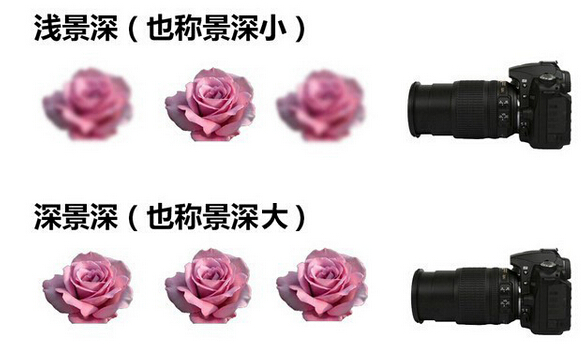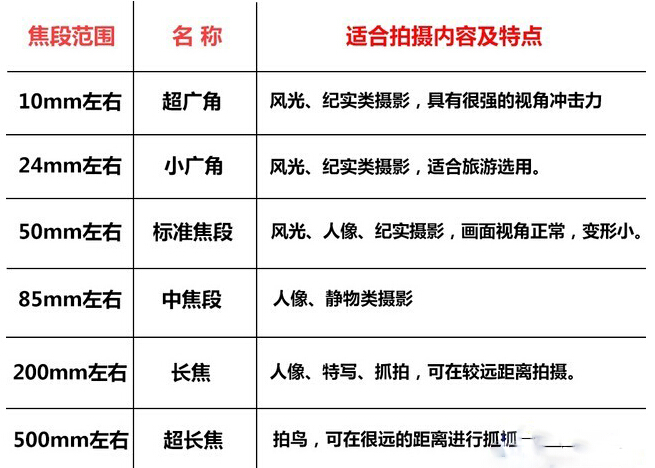Depth of field refers to the range of front and back distances of the object measured by imaging that can obtain a clear image at the leading edge of a camera lens or other imager. After the focusing is completed, a clear image can be formed within the range before and after the focus. This distance between the front and back is called the depth of field. There is a certain length of space in front of the lens (before and after the focus adjustment). When the subject is in this space, the imaging on the film is between the two converging circles before and after the focus. The length of the space in which the subject is located is called the depth of field. In other words, the ambiguity of the subject in this space, which is present on the film surface, is within the allowable circle of the confusion circle. The length of this space is the depth of field.
When the lens is aimed at the subject, there is a clear range of the subject and its front and rear scenes. This range is called the depth of field. The degree of clearness of the images within the depth of field is also different, with the sharpness of the focus of the scene being the highest and the other parts decreasing in direct proportion to the distance of the focal point.

What is the deep depth of field and shallow depth of field we often hear? For example, if you use a SLR camera to shoot a model, you only want the subject to be clear and the background to be blurred. The effect of this blurred background is very shallow (deep depth of field). On the contrary, when you are taking landscapes, you hope that the entire picture is clear and distant. The effect of this blurring effect is deep depth of field (deep depth of field).
What is the depth of field? 1. The depth of the subject (hierarchy)
The visual sensation brought about by the depth of the depth of field will make the picture more space-depth sense, which is the so-called layering. For example, we often use the following shooting tactics: In the same parallel line, the objects are arranged regularly and in different distances, and the presented size is also different. The resulting visual size is different.
2, highlight the subject
Sometimes the background in your shooting environment is too cluttered. If you have a large depth of field and collect messy backgrounds, it will inevitably make the whole photo lack beauty. The small depth of field with obvious blurring effects will support the characteristics of the subject and make the picture appear more clean and lively. If the localization is appropriate, it can also add some imagination to the picture, which is more attractive.
In the past, when the author didn't understand the definition of depth of field, he communicated with the photographer every time and only knew that I wanted a photo with obvious blur effect. Although the other party would understand it, it was enough to know that I was really a layman. Presumably there are many students like the author, especially girls. What are the factors that affect the size of the depth of field? This consists of three major elements that influence the exposure and the same reasons.
The three factors that determine the depth of field, the aperture size
The larger the aperture, the smaller the depth of field, the smaller the aperture, and the greater the depth of field. If you have read the previous article on impact exposure, the concept of aperture should be understood. If you don't look at it, the simple thing is that if you shoot with a large aperture, the background blur effect will be more pronounced, and the small aperture will be the opposite. The so-called large aperture is the smaller F number, such as F1.2, F1.4, F2.8 and so on. Generally F8 and above are all small apertures, shot with a small aperture, the greater the depth of field.

In portraits, still life, flowers, animals, etc., many photographers will choose a small depth of field to better highlight the subject. In scenery shooting, relatively large depth of field is used more often. Therefore, the white people do not have large aperture lenses when they purchase the lens. On the one hand, they can use the shallow depth of field effect, but also help to shoot in a dark environment.
2. Shooting Distance Distance The closer the subject is to the lens, the smaller the depth of field; the farther the subject is from the lens, the greater the depth of field. In some portrait shootings, many people in the past have always pursued a strong background blurring effect. Sometimes it may not be really good-looking. Appropriately creating some sense of ambiguity, the whole picture is more gray, combined with the aperture lens focal length to change the depth of field, but also by changing the distance from the subject's shooting distance. I use the previous set of maps to illustrate this issue will be more intuitive.
3, the focal length of the lens The longer the focal length, the smaller the depth of field, the shorter the focal length, the greater the depth of field. This involves the length of the focal length of the lens. In short, when you shoot with the telephoto end, the effect of background blurring is more pronounced; short focal length brings with it a large depth of field effect. Although these three points have an impact on the depth of field, the ultimate depth and effect still need to be taken together. For example, if you use a telephoto end, depending on the aperture size or the shooting distance, the depth of field effect will be different. The first SLR camera that most users start with will be equipped with a medium telephoto lens, because of its wide applicability, so if you want a shallow depth of field effect in actual shooting, use the telephoto end of the lens.
The depth-of-field effect of the short-focus and telephoto ends is completely different. Speaking of the focal length, you need to talk about a situation. Sometimes, in the case of the same lens, focal length, aperture, and distance, you use a different format of the camera. The depth of field is also different. The reason is the conversion of the coefficients of the equivalent focal length (actual focal length), and the physical focal length.
Extending the factors that indirectly affect the depth of field
Speaking of focal lengths for small white users, in the actual purchase of the lens, may be confused about what kind of lens to choose, we may wish to take a look at the following summary of the different focal lengths of the lens suitable for shooting themes.

The above can be used for certain reference, but the actual shooting still needs to be used in a live and inactive manner. It is not entirely consistent with having a camera of its own. For the camera, in addition to the main reasons mentioned earlier, we need to understand the other two influencing factors. .
1, the physical focal length physical focal length is simply the focus of the lens marked on the value, in the full-frame camera on the perspective of the physical focal length did not change. For example, if it is 50mm, then the actual viewing angle reached is 50mm. In the APS-C format camera, the actual focal length of the camera is not 50mm, which requires a numerical conversion. It also needs to be remembered.

2, the equivalent focal length (also known as the actual focal length)
The equivalent focal length is also the value of the focal length after the physical focal length is converted. In addition, the actual focal length of the lens is actually a physical parameter and does not really change. Only the perspective is changed. We must remember the lens conversion factor:
Canon lens focal length value × 1.6, for example, I use a Canon 50mm lens, multiplied by 1.6, the actual focal length is equivalent to 80mm.
Nikon, Sony, Samsung focal length value × 1.5
Panasonic, Olympus focal length value × 2
3, the impact of the size of the photosensitive element on the depth of field Why APS-C camera we see will be the effect of different focal lengths. This is because the cameras of different frame sizes have different sizes of photosensitive elements. The biggest core difference between digital card camera, APS-C camera and full-frame camera is the difference in the size of the photosensitive element. Simply speaking, the large photosensitive element is not only the core technology of the camera, but also one of the factors affecting high image quality. And with the same focal length equivalent, the larger the photosensitive element, the shallower the depth of field. This may be a bit general to Xiao Bai, so let's use an analogy.
We used the small, medium, and large three-mirror mirrors to compare the size of the three cameras. The size of the mirror determines how much of the picture can be received. If you want all three lenses to show the whole body of a person, it is known that only by changing the distance between the mirror and the person can the whole body be photographed. According to the factors that affect the depth of field mentioned earlier, the closer the distance, the smaller the depth of field and the more obvious the blur effect. This will inevitably affect the effect of depth of field indirectly. So the result is as follows:


The contents of the screen received by different sensor sizes (1) Large mirror (full-frame camera): This person can directly take all photos down, so the photographer does not need to change the position, and it is very close to the camera. The depth of field is small.
(2) Medium Mirror (APS-C): The medium is relatively incapable of fully photographing the entire body of the character. Therefore, the photographer needs to retreat appropriately and be slightly away from the subject, so the depth of field effect may be large.
(3) Small mirror (digital DC): Due to the limitations of the size of the mirror, the photographer can only take a lot of time to photograph the subject. Because of the distance, the depth of the picture will be great.
Having said so much, it is time to share the assignments. I do not know whether the white screen in front of the screen is the same as the author and insists on practicing shooting. Photography is a process that requires repeated practice because many principles can only be learned under multiple practices. Thoroughly and remember.
Let us review the main points. The three decisive factors that affect the depth of field are: the aperture size, the distance between the camera and the focal length. There are two other non-negligible indirect influences: the equivalent focal length and the size of the camera's sensor. The above points you need to keep in mind, the equivalent focal length conversion must also remember Oh! When sharing learning points and experiences, it is also revisited by oneself. If there is misunderstanding, it is hoped that the photographers will correct them and the camera will provide better learning support.
If some flies survive from the larvicides and grown up, the we can use some Aduticides to kill them. Fly Bait such as Azamethiphos 1% GB (Snip Fly Bait), Thiamethoxam 1% GB (Agita 1GB) usually used for the Public Health while Azamethiphos 10% WP (Alfacron 10) and Thiamethoxam 10% WDG(Agita 10 WDG) and some Pyrethroid products (Cypermethrin, Permethrin), DDVP are usually used in poultry.
Adulticide
Mosquito Larvicide,Mosquito Control,Mosquito Repellent,Mosquito Larvicide Spray
Hebei Senton International Trading Co.,Ltd. , https://www.sentonpharm.com